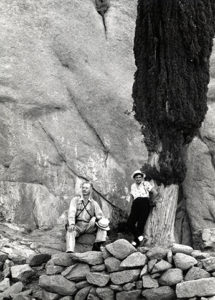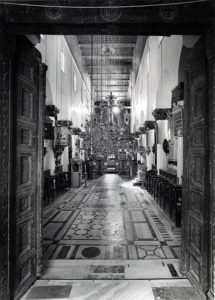Magazine

Interpreted Witness
Part Indiana Jones and part academic scholar, George Forsyth traveled the world documenting sacred sites and undertaking ambitious archaeological surveys, including that of St. Catherine’s Monastery in Egypt. His collection at the Bentley is full of priceless details about holy structures, many of which have already been lost to the ravages of war and time.
By Mary Jean Babic
Nestled into the granite slopes of Mount Sinai, in Egypt, St. Catherine’s Monastery occupies, as its website describes it, “God-trodden” land. This is where, it is believed, Moses spoke to God through the burning bush and, on top of the mountain, received the Ten Commandments. Built in the sixth century during the reign of Emperor Justinian, St. Catherine’s— commonly referred to simply as Sinai—is the oldest continuously inhabited Christian monastery in the world. For 1,500 years it has welcomed pilgrims, served as a fortress against invaders, and housed priceless Byzantine art. To this day, Greek Orthodox monks rise at four o’clock in the morning to keep canonical hours behind the ancient stone walls, in the spiritual tradition of retreat from the world.
Despite its longevity and historical importance, Sinai had never been the subject of an in-depth archaeological study until the mid-1950s. That’s when George H. Forsyth Jr., then a professor in and chair of U-M’s History of Art Department, arrived at Sinai for the first time. Already a veteran of excavations in France, Turkey, and the Near East, Forsyth, then in his mid-50s, was scouting his next adventure.
Sinai would prove to be his biggest.
Forsyth’s early Sinai explorations grew into the Michigan-Princeton-Alexandria Expeditions, a multiyear, three-university project led by Forsyth that brought dozens of specialists and literally tons of equipment into the desert to perform a top-to-bottom survey of Sinai’s archaeological features and art treasures. Research teams worked at Sinai during months-long campaigns in 1958, 1960, 1963, and 1965.
Significantly, Forsyth produced the first measured drawings ever done of the monastery. He completed in-depth, drawn-to-scale renderings of every site he ever visited. To Forsyth, they were a form of time travel, his way of entering the minds of original builders to puzzle out why they did what they did. Elizabeth Sears, current chair of U-M’s History of Art Department, calls them “interpreted witness” and Forsyth’s “big gift” to posterity. In fact, several sites Forsyth studied and drew have recently been damaged by the Syrian Civil War, giving his work urgency as history is obliterated.
The timing is propitious, then, for the Bentley Historical Library to welcome the George Forsyth papers. Donated by Forsyth’s wife, Ilene, professor emerita of art history, the collection overflows with sketches, letters, notebooks, photographs, packing lists, and field notes. Taken together, the contents evoke a bygone era when a certain kind of life was possible— one of far-flung, safari-hatted adventures balanced with deep scholarly work.
Born to an affluent Chicago family in 1901, George Forsyth came of age between the wars. After graduating from Princeton University (B.A. ’23, M.F.A ’27), he sailed off through Upper Egypt, Lebanon, and Syria to study ancient architecture. Even then, he was constantly drawing. “I sketch as often as I brush my teeth, only oftener,” Forsyth wrote to Albert Friend, an art historian from Princeton.

George (left) on the slopes of Mt. Sinai.
In a 50-page missive to Friend in 1924, Forsyth describes Baalbek, a Roman ruin in Lebanon: “And the high entablature, breasted out in luscious richness of profuse ornateness, somehow has in it the roar of the arena on a pagan holiday, all the pomp and circumstance, the luxury and lust of great Rome.” He goes on to describe, equally rapt, the ancient Semitic city of Palmyra.
Between 2015 and 2017, Palmyra suffered extensive damage while occupied by ISIL, which reportedly used its theater for public executions. (Locals have also said they’ve witnessed the Syrian air force dropping bombs.) Another Syrian site Forsyth studied, the Umayyad castle Qasr al-Hayr, has also been damaged in recent years. And in May, air strikes hit the Byzantine monastery Qalaat Semaan, a UNESCO World Heritage site in Aleppo that Forsyth visited in 1954. The archive holds at least two dozen photographs from that trip.
The Sinai monastery remains intact, but art historians know all too well how much cultural heritage a single missile can wipe out. That awareness drives staff members of the Visual Resources Collection (VRC) in U-M’s History of Art Department. In addition to creating images for teaching, the staff in the basement of Tappan Hall digitize slides, photographs, and illustrations of “places that might be at risk,” says Sally Bjork, a photographer and VRC digital specialist.
The VRC’s catalog now contains more than 500,000 images, 10,000 of which are of Sinai during the Michigan- Princeton-Alexandria Expeditions. Photography of Sinai was under the direction of Fred Anderegg, a Michigan photography legend who created U-M’s centralized Photo Services department and, beginning in the 1950s, took part in several university archaeological expeditions. At Sinai he was essential, photographing the monastery’s structural aspects as well as its icons, frescoes, and mosaics with precise detail and composition.
At Sinai, Forsyth focused on architecture while Princeton art historian Kurt Weitzmann turned his attention to Sinai’s world-renowned collection of icons, many of which pre-date bans on religious imagery that began in the eighth century. (Princeton now maintains its own Sinai archive of thousands of icon images.) A third scholar, Ahmed Fikry of Alexandria University, studied the monastery’s Islamic antiquities.
Forsyth and Weitzmann planned an ambitious series of publications. However, only two books were produced: Weitzmann’s study of icons, and a volume of Anderegg’s photographs (both Forsyth and Weitzmann contributed forwards, so it’s likely that their rift healed at some point). In 2016, some of Forsyth’s drawings, and his analysis of the monastery’s architecture, appeared in print, in a paper co-authored by Ilene Forsyth and Sears—colleagues since Sears came to Michigan the year following George’s death—that appeared in the journal Dumbarton Oaks Papers.

View of the nave of the sixth-century basilica.
Forsyth, Ilene writes, was often asked why he went to the pains of drawing. Why not just take pictures? “In the manual act of drawing with pencil on paper (he always had pencils ranging from blunt to needle sharp at hand), he was able to learn as he synthesized,” Ilene writes. “As he moved from first on-site sketches through to finished drawings, he came to see the logic of the builders’ choices.” Forsyth’s drawings “even now encourage fresh thinking about the challenges that were identified and ingeniously met by the sixth-century architect and the artisans who worked with him on the mountain.”
Forsyth came to disagree with earlier scholars that Sinai had been constructed primarily to showcase the burning bush. Just as important, if not more, was the placement of 3,000 stairs up to the mountaintop where the Ten Commandments were given to Moses, indicating that the monastery was arranged to maximize the religious significance of the entire site, not just the bush. Among Forsyth’s other conclusions:
To contend with the steep hillsides, the builders incorporated granite outcroppings into the structures, strengthening them to ensure a long life. The monastery probably wasn’t very effective as a fortress; invaders could easily clamber up the sloped hills and drop in over the northern wall. In a narrow valley prone to flash flooding, the monastery employed a sophisticated system of terraces, sluice gates, and underground passages that both retained and diverted water, as needed.
In every aspect of his analysis, he was led by the insight gained through his drawings. Forsyth never signed his drawings but in the edges often included, amusingly, a silhouette of a man performing a survey. This meta trademark parallels Forsyth’s lifelong compulsion to envision what came before the ruin, to place himself among the living, breathing people who passed through a site at its heyday.
“[T]hey always remain as shadows and the lingering feeling exists…that their actual reality, their true substance, is still hidden, elusive, barely lurking behind the stones and the sherds,” he wrote in an unpublished forward found in his papers. “It is to them, princes and peasants, nomads and sedentary, local inhabitants or passing travelers, that this work is dedicated, for, even if what has been uncovered is but a fraction of what they were, even if the interpretations proposed are mistaken, it is only with a sense of humble respect for a strangely superb achievement that we today may be permitted to unveil what time and nature had covered up.”
The George Forsyth papers have been digitized and are available online as well as in-person at the Bentley Historical Library.
